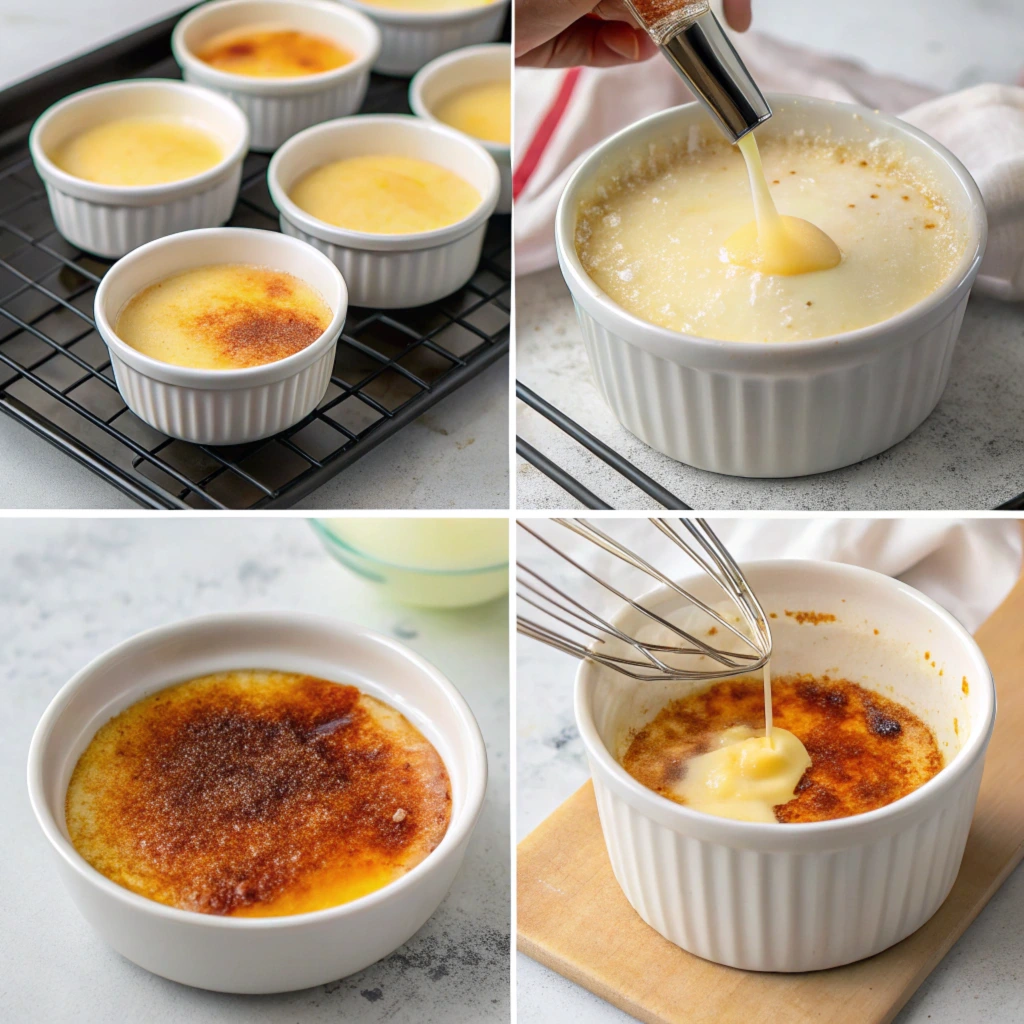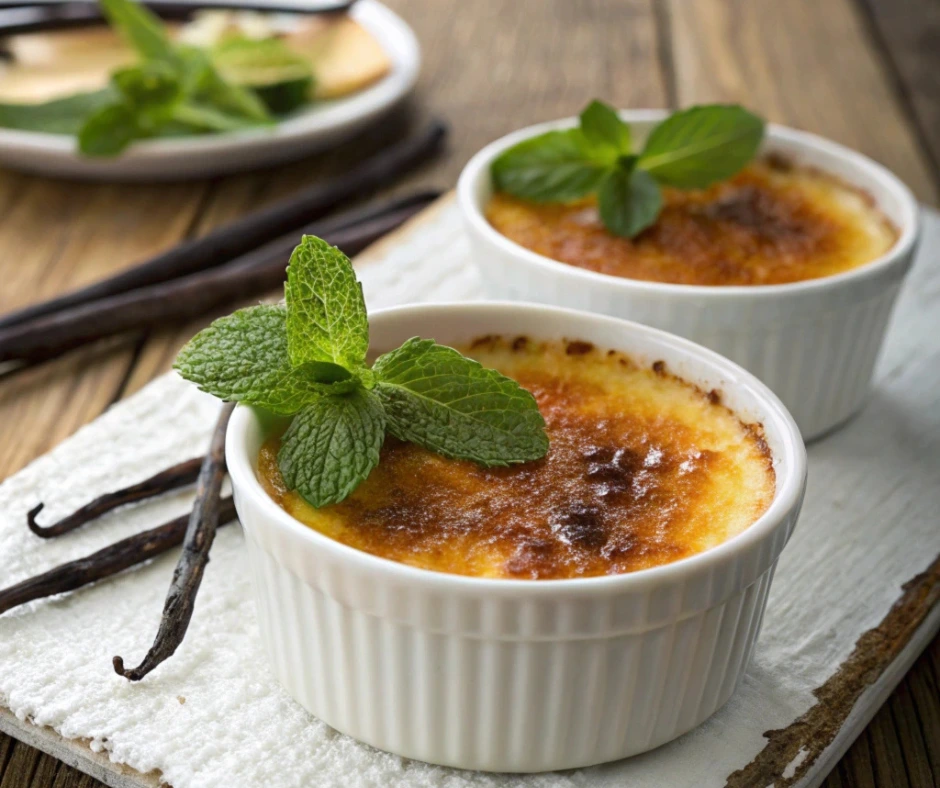Crème brûlée, often hailed as the crown jewel of French desserts, captivates gourmands worldwide. Its velvety custard base and caramelized sugar crust showcase what is the secret to crème brûlée: a perfect contrast of textures and flavors. Achieving this delicate balance isn’t simple, but it’s well worth the effort. In this article, we’ll uncover the secret to crème brûlée by exploring its origins, ingredients, techniques, and tips. Whether you’re a novice or a seasoned baker, you’ll learn everything you need to master this timeless dessert.
Let’s dive into the sweet history of crème brûlée and explore what makes it such a timeless classic.
The Origins of Crème Brûlée
History and Evolution of Crème Brûlée
The history of crème brûlée, or “burnt cream,” is as rich as its custard base. Exploring what is the secret to crème brûlée reveals a dessert believed to have originated in France, with recipes dating back to the 17th century. However, a culinary debate lingers, as Spain’s crema catalana and England’s Trinity Cream also lay claim to similar creations.
In its French form, crème brûlée became famous for its caramelized sugar topping, a hallmark of the secret to crème brûlée. Perfected using a broiler or handheld torch, this burnt sugar layer seals the custard and delivers the iconic “crack” when tapped, making it a symbol of refined indulgence.
Cultural Significance and Variations Across the World
Although it’s closely tied to French cuisine, crème brûlée has traversed borders to find variations and adaptations worldwide. In Spain, it’s infused with citrus and cinnamon as crema catalana, while in England, the custard is often lighter and baked in one large dish. Modern interpretations introduce bold flavors like matcha, espresso, or lavender, transforming this classic into a canvas for creativity.
Today, crème brûlée remains a hallmark of fine dining and a beloved indulgence for special occasions, symbolizing both sophistication and comfort.
Key Ingredients for a Perfect Crème Brûlée
Essential Ingredients: Heavy Cream, Egg Yolks, and Sugar
At the heart of crème brûlée lies its trio of key ingredients: heavy cream, egg yolks, and sugar. These staples combine to create the dessert’s silky texture and rich flavor. Heavy cream provides the custard’s signature creaminess, while egg yolks lend it structure and a luxurious mouthfeel. Sugar, on the other hand, sweetens the mixture and later transforms into the iconic caramelized crust.
Balancing these ingredients is crucial. Too much cream can result in a runny custard, while excessive sugar may overpower the dish. A golden rule? Stick to high-quality products, pure vanilla extract or fresh vanilla beans are non-negotiable for authentic flavor.
The Role of Vanilla: Extract vs. Beans
Vanilla plays a starring role in the flavor profile of crème brûlée. Pure vanilla extract works wonderfully, but if you want a truly aromatic dessert, use fresh vanilla beans. Splitting a vanilla bean pod and scraping out the seeds not only enhances the flavor but also adds a visual appeal, with tiny flecks dotting the custard.
For a twist, consider experimenting with flavor infusions like orange zest or coffee. These subtle additions complement vanilla while putting a unique spin on the classic.
Alternative Ingredients for Unique Flavors
In recent years, chefs have embraced creativity with crème brûlée. Heavy cream can be swapped with coconut milk for a dairy-free version, or seasonal ingredients like pumpkin puree can be folded into the custard for a festive flair.
Ultimately, the secret to crème brûlée lies in the quality of its ingredients. By focusing on the freshness of vanilla beans, cream, and eggs, you can master what is the secret to crème brûlée and craft a dessert that’s not just delicious but truly unforgettable.

The Art of Making Crème Brûlée
Choosing the Right Ramekins
Selecting the correct ramekins might seem trivial, but it’s essential for crafting the perfect crème brûlée. Opt for shallow ramekins that allow the custard to cook evenly while creating the ideal sugar-to-custard ratio. Deeper ramekins are best reserved for those who prefer a creamier center.
Additionally, ensure your ramekins are oven-safe. This small step helps avoid mishaps and ensures a smooth baking process.
Preparing the Custard Base: Tips for Consistency
Creating a custard base requires attention to detail. Begin by whisking the egg yolks and sugar until pale and slightly thickened. This step ensures a smooth texture and prevents curdling during baking.
Warm the heavy cream gently, avoiding a full boil. Gradually temper the egg mixture by adding the cream in small increments. This prevents the eggs from scrambling, preserving the custard’s silky consistency.
The Importance of Tempering Egg Yolks
Tempering is one of the key secrets to crème brûlée. Pouring hot cream directly into egg yolks can result in a lumpy mess, but tempering slowly mixing hot cream into the yolks creates a smooth, velvety mixture.
Cooking Techniques: Bain-Marie for Even Baking
To achieve even cooking, use a bain-marie, or water bath. Place the ramekins in a roasting pan, then fill the pan with hot water until it reaches halfway up the ramekins. The water bath prevents the custard from overheating, ensuring a creamy texture without cracking.
Bake the custard at a low temperature, usually 325°F, and keep an eye on it to avoid overcooking. The edges should set while the center remains slightly jiggly.
Caramelizing the Sugar: Achieving the Perfect Crust
No crème brûlée is complete without its caramelized sugar topping. After chilling the custard, sprinkle a thin, even layer of sugar on top. Using a kitchen torch, move the flame in small, circular motions until the sugar melts and turns golden brown.
For those without a torch, a broiler can suffice, but watch closely to prevent burning. The crisp, glassy sugar crust is what makes crème brûlée so iconic, providing that satisfying “crack” with every spoonful.
By mastering these steps, you’ll unlock the secret to crème brûlée and impress with a dessert that’s as stunning as it is delicious.
Troubleshooting Common Issues
Why is My Custard Runny?
A runny custard is a common frustration when making crème brûlée. This issue often stems from improper baking or ingredient ratios. If your custard doesn’t set, it could be due to undercooking. Always bake the ramekins in a water bath at a low temperature, usually 325°F, for even heat distribution. The custard should jiggle slightly in the center when done, as it will continue setting while it cools.
Using the wrong ratio of cream to egg yolks can also lead to a thin consistency. Stick to a tried-and-true recipe to avoid this problem. Lastly, avoid overmixing, as it introduces too much air, which can affect the custard’s texture.
Preventing a Cracked Surface
A cracked surface occurs when the custard overheats or cools too quickly. To prevent this, never skip the water bath, it maintains a stable temperature throughout the baking process. Additionally, avoid opening the oven door frequently, as temperature fluctuations can lead to cracks.
Once baked, let the ramekins cool to room temperature before refrigerating them. Rapid cooling can cause the custard to contract and crack.
How to Fix Overcooked or Undercooked Crème Brûlée
Overcooking results in a rubbery texture, while undercooking leaves the custard too soft. To avoid both, keep a close eye on the baking process. Use a thermometer to ensure the custard reaches about 170°F. If you’re unsure, err on the side of slight undercooking the custard will firm up in the fridge.
For more tips on custard desserts, check out our guide on How to Make Crab Brûlée Recipe.
Secrets to Elevating Crème Brûlée
Using Fresh Vanilla Beans for an Authentic Flavor
One of the secrets to extraordinary crème brûlée is the use of fresh vanilla beans. Their rich, floral aroma elevates the custard, setting it apart from versions made with artificial flavoring. Simply split the bean, scrape out the seeds, and steep them in warm cream to infuse every bite with authentic vanilla flavor.
Infusing Uncommon Ingredients: Lavender, Citrus, or Matcha
If you’re feeling adventurous, add a twist to the classic recipe with unique flavors like lavender, citrus, or matcha. A hint of lavender lends a floral note, while citrus zest provides a refreshing tang. For a bold departure, matcha powder adds a vibrant green hue and earthy taste.
When experimenting with new ingredients, balance is key. Too much of a strong flavor can overpower the delicate custard.
Pairing Crème Brûlée with Wines or Desserts
Pairing crème brûlée with complementary desserts or wines can elevate your dining experience. A crisp white wine, such as Riesling, balances the richness of the custard, while fresh berries add a tart contrast to the sweetness.
By incorporating these tips and tricks, you’ll transform your crème brûlée into a masterpiece worthy of any special occasion. For more inspiring recipes, explore other ideas on our website, like How to Make Crab Brûlée Recipe.
Crème Brûlée Variations and Innovations
Fusion Recipes: Chocolate, Coffee, and Seasonal Fruits
Why stick to the classic when you can experiment? Crème brûlée serves as the perfect canvas for creative flavors. Chocolate lovers can fold in melted dark chocolate to create a decadent twist, while a splash of espresso transforms it into a coffee-lover’s dream. For a refreshing option, incorporate puréed fruits like mango, raspberry, or passion fruit into the custard for a fruity flair.
To maintain the dessert’s signature texture, ensure any added ingredients are blended smoothly into the custard base. With these variations, you’ll give your crème brûlée a modern and personalized touch.
Vegan and Dairy-Free Alternatives
Creating vegan or dairy-free crème brûlée may seem tricky, but it’s entirely possible. Replace heavy cream with coconut cream or almond milk for a creamy, plant-based custard. Instead of egg yolks, use cornstarch or agar-agar as thickeners.
The caramelized sugar topping remains unchanged, giving this variation the same satisfying crunch. Vegan crème brûlée proves that dietary restrictions are no barrier to indulgence!
FAQs: Answering the Most Common Questions
Can Crème Brûlée Be Made Ahead of Time?
Absolutely! In fact, making crème brûlée ahead of time allows the custard to chill and set perfectly. Prepare and bake the custard a day in advance, but wait to caramelize the sugar topping until just before serving. This ensures the crust remains crisp and fresh.
What Tools Do I Need to Make Crème Brûlée?
The essentials include ramekins, a whisk, and a kitchen torch for caramelizing the sugar. If you don’t have a torch, you can use your oven’s broiler, but be vigilant to avoid burning. A thermometer can also help ensure the custard is baked to the right temperature.
How Do I Ensure a Crunchy Caramelized Top?
Achieving a crunchy top requires evenly spreading a thin layer of sugar over the chilled custard. Using a kitchen torch, move the flame in small circles until the sugar melts and browns. For extra crispness, let the first layer cool, then add a second layer of sugar and caramelize again.
By addressing these questions, you’ll be well-equipped to master the art of crème brûlée. Whether you’re preparing the classic version or trying bold new variations, this dessert is sure to impress.
The Ultimate Crème Brûlée Experience
The Sensory Appeal of Crème Brûlée
The allure of crème brûlée lies in its ability to tantalize the senses. From the first “crack” of the caramelized sugar crust to the creamy, melt-in-your-mouth custard, every bite is a delight. The contrast between the crisp topping and the smooth base creates an experience that’s both luxurious and comforting.
Its rich vanilla aroma fills the air, teasing your taste buds before the first spoonful even reaches your mouth. The golden crust, kissed by the flame, adds a caramelized sweetness that perfectly balances the custard’s subtle flavor.
Making Crème Brûlée a Showstopper
Presentation matters when serving crème brûlée. Garnish each ramekin with a sprig of fresh mint, a scattering of berries, or a twist of citrus peel. These simple touches not only enhance the dessert’s visual appeal but also complement its flavors.
For an unforgettable dining experience, serve crème brûlée as the finale to a special meal. Pair it with a glass of sparkling wine or coffee to complete the moment. With its timeless elegance, crème brûlée isn’t just a dessert, it’s a celebration of flavor, texture, and artistry.
By mastering this classic, you’ll not only unlock its secrets but also bring joy to anyone lucky enough to share in its magic.

